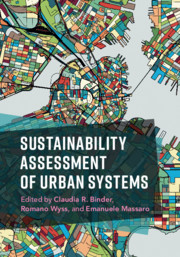Book contents
- Sustainability Assessment of Urban Systems
- Sustainability Assessment of Urban Systems
- Copyright page
- Contents
- Preface
- Acknowledgments
- Contributors
- General Introduction
- Part I Theoretical Background
- Part II Integrative Approaches for Sustainability Assessment
- Part III Perspectives on Urban Sustainability
- 10 Conceptualizing Urban Systems for Sustainability Assessment: Four Powerful Metaphors
- 11 Sustainability Issues in Urban Systems from a Metabolic Perspective
- 12 Urban-Industrial Supply Systems
- 13 Indicators for Assessing the Sustainability of Cities
- 14 Ontology-Based Integration of Urban Sustainability Indicators
- Part IV Focal Points of Urban Sustainability
- Index
- References
13 - Indicators for Assessing the Sustainability of Cities
from Part III - Perspectives on Urban Sustainability
Published online by Cambridge University Press: 27 March 2020
- Sustainability Assessment of Urban Systems
- Sustainability Assessment of Urban Systems
- Copyright page
- Contents
- Preface
- Acknowledgments
- Contributors
- General Introduction
- Part I Theoretical Background
- Part II Integrative Approaches for Sustainability Assessment
- Part III Perspectives on Urban Sustainability
- 10 Conceptualizing Urban Systems for Sustainability Assessment: Four Powerful Metaphors
- 11 Sustainability Issues in Urban Systems from a Metabolic Perspective
- 12 Urban-Industrial Supply Systems
- 13 Indicators for Assessing the Sustainability of Cities
- 14 Ontology-Based Integration of Urban Sustainability Indicators
- Part IV Focal Points of Urban Sustainability
- Index
- References
Summary
Sustainability assessment initiatives at the local level have been increasing in number since the mid-1990s and are now plentiful. The definitions of sustainable development used in sustainability assessment instruments, however, vary widely. This chapter illustrates the diversity of sustainability assessment tools available at the local level by presenting two indicator-based instruments developed in Switzerland. The first one, Cercle Indicateurs, is an all-encompassing sustainability assessment tool; the second one, Swiss City Statistics, focuses on the well-being and quality of life dimensions of sustainability. The two instruments are presented and analysed according to the Bellagio Sustainability Assessment and Measurement Principles (Bellagio STAMP), which have been grouped into five categories: (1) conceptual framework, (2) time and spatial scale, (3) participation, (4) transparency and communication, and (5) continuity and capacity. We suggest that transparency about the rationale for setting up a sustainability assessment instrument and about its actual implementation is crucial, because these aspects influence how ‘sustainability’ is operationalised and therefore the result of the assessment.
- Type
- Chapter
- Information
- Sustainability Assessment of Urban Systems , pp. 311 - 331Publisher: Cambridge University PressPrint publication year: 2020



